By Joe Jaroch – Posted with Permission from AUCM
Amassing a collection of ancient coins can seem like a daunting task: the U.S. Mint has existed for little more than two hundred years, but the Classical world spans a colossal twenty-one centuries. Where would a collection begin, let alone end?
That’s where we come in.
You don’t need to own a museum or be a Rockefeller to collect ancient coins. There are indeed thousands of possible collections, but we’ll cover the ones that could be most comfortably completed, including variations based on the overall price tag: some sets have individual coins that could run into the hundreds of thousands of dollars, but there are alternate sets and subsets which are equally exciting and historical at more affordable prices.
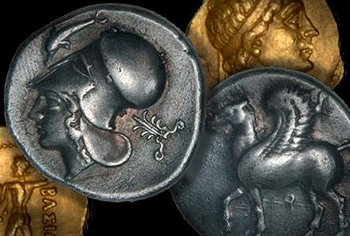 But even though ancient coins have been collected by such noteworthy historical figures as Thomas Jefferson, Louis XIV, and Augustus Caesar himself, the field is open to all comers. We have observed that the market on these coins is less mature than that of U.S. ones, so coins of smaller mintage and greater intrinsic value are actually far less expensive today than their American counterparts. Additionally, there is such an extensive pool of variations that you could contentedly collect for decades to come and never run out of new sets to complete.
But even though ancient coins have been collected by such noteworthy historical figures as Thomas Jefferson, Louis XIV, and Augustus Caesar himself, the field is open to all comers. We have observed that the market on these coins is less mature than that of U.S. ones, so coins of smaller mintage and greater intrinsic value are actually far less expensive today than their American counterparts. Additionally, there is such an extensive pool of variations that you could contentedly collect for decades to come and never run out of new sets to complete.
For example, while less well-known than the Twelve Caesars, the Five Good Emperors, who form a dynasty that follows the first 12, have coins that are truly remarkable in artistry and equally rich in history as the prior dynasties but generally at even more affordable prices today. The world of ancient coins makes available numerous denominations in which to collect, including several incredibly large offerings that would add a unique element to any collection, and the stunning detailing on these hand-struck pieces is even more obvious and easier to appreciate.
There is a vast array of collections and sub-collections to choose from, with appreciation for the rarity and quality of the coins weighing in the same as in an American collection. But we’ve done the heavy lifting for you by determining the potential nature of sets in addition to considering the current market value to keep your wallet and your conscience at ease, so all you have to do is decide which period of ancient history you want to be a part of.
Choosing Quality Examples
Before diving into the suggestions on different collections, here are a few thoughts to keep in mind as you build your collection. As with US coins, we suggest looking for the best example in a particular grade. There is no set ratio for how much more an “Extremely Fine” example costs versus a “Very Fine” coin, but in general, the prices increase significantly as the grade increases. In some cases, low-grade examples of a coin may sell for a few hundred dollars and the finest known of the same type would realize a thousand times as much at auction.
As with anything, supply and demand drive the prices of ancient coins. One of the most famous ancient coins, the Ides of March denarius, commemorating Brutus’ assassination of Julius Caesar, frequently sells for US$100,000 or more. There are less than 100 examples of this coin available and thousands of collectors who want one, so they command strong prices. However, just because a coin is 2,000 years old does not mean it must be expensive. There are many coins of stunning beauty from all areas of ancient history which can be owned in a problem-free condition with great detail for well under $1,000. We will look to describe the full range of coins, from common coins to ultra-rarities, to allow you to be aware of what is available for you to collect today or to aspire to acquire in the future.
The grade and level of preservation of an ancient coin is viewed similarly to US coins but with a few added metrics. As these coins have had to weather the sands of time for millennia, they can come with problems not often seen on US coins. Mineral deposits, low metal quality, and various forms of corrosion occur frequently on ancient coins and we suggest looking for coins that are as problem-free as possible. The Numismatic Guaranty Corporation (NGC) which grades US coins has also recently begun grading ancient coins, encapsulating them in plastic slabs and assessing their detail, strike, and surface quality. While many ancient collectors want to feel their coins and avoid “slabbing” coins which have otherwise existed unharmed for thousands of years, it may be helpful to start collecting with the added level of security brought by an NGC slab. Many problems which adversely affect the grade of a coin are difficult to detect, especially when buying online through pictures. Ancient coins frequently had their edges filed or otherwise damaged and these problems, which impact the price of a coin dramatically, are almost impossible to find unless examining the coin in-hand. NGC’s experts personally examine each coin and look for problems such as edge bumps, graffiti, metal instabilities, and damage, noting them on the front of the holder. Even so, we strongly recommend working only with trusted dealers, and the mantra of “buy the coin, not the holder” applies to both US and ancient coins.
Unlike U.S. coins where style is consistent across most issues, ancient coins have a wide variety of obverse and reverse types, with some emperors having literally thousands of coins with distinct designs to collect. Coins were engraved by some of the leading artists of antiquity and their finest works command a premium over less artistic examples. Additionally, as these coins were struck by hand instead of using closely regulated machines, the accuracy and centering of the strike and the details imprinted on a coin affect the price and value. It is best to look for a well centered coin where all of the intended details are visible.
In ancient coins, rarity is a difficult attribute to ascertain. Despite being hand-struck, ancient coins were often produced in remarkable volumes and there are a sizable number that still survive today in all denominations. Hoards of coins are found from time to time which adjust the overall known populations, so rarity is generally not completely firm. That being said, there are definitely issues which are historically known to be common, and others of which there were very few examples minted. We suggest avoiding purchasing a coin only because it is labeled as rare, and rather take into account the other factors we’ve outlined which tend to affect price and long term value to a larger extent.
There is a lot to take into consideration when choosing an ancient coin and we suggest looking at as many coins as possible and working with a trusted dealer to help grow your collection and fill it with quality examples.
Eras of Antiquity
Coinage started in about 700BC when Lydian electrum, an alloy of silver and gold, was mined and minted into ingots stamped with its purity level. These early coins come in a variety of denominations, with some weighing only a fraction of one gram up to sixteen grams or more. The reverse of Lydian electrum was punched with an incuse square, pushing down fairly deeply into the coin to prove that it wasn’t just a plated, less valuable metal. The obverse identified the region from which a coin originated and so began the practice of promoting the skill and artistry of the kingdom issuing the currency.
In choosing what to collect, it may help to identify historic areas of interest. In numismatics, the ancient world is often described as ranging from around 700BC to 1453AD when Constantinople fell to the Turks.
The two primary cultures of the ancient world were Greece and Rome, with Greece’s coinage predating that of Rome’s by a few hundred years. The artistic styles of each are very different, as are the variations of collections one can start. Some collectors choose to focus on one or the other, but it can be very enjoyable to focus on a wider range across multiple areas of history.
Because of their relatively contemporary existence, Greece and Rome share several historical and mythological figures, allowing a collection to span both cultures while remaining focused on a single overarching theme. Conversely, many collectors prefer a more specific focus, narrowing down to a single emperor, dynasty, or design. We will attempt to give you as many options as possible in building your collection so that you can decide where you would like to start your journey into the ancient world.
Ancient Greece
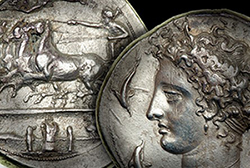 Ancient Greece is generally broken up into three primary eras: Archaic, Classical, and Hellenistic. There is some overlap between these periods but each has distinct attributes. The Archaic period marked the beginning of coinage itself, starting with the Lydian electrum staters and moving into distinct gold and silver coinage. The designs can sometimes appear crude and unskilled, but this is due primarily to the relative youth of the concept of coinage.
Ancient Greece is generally broken up into three primary eras: Archaic, Classical, and Hellenistic. There is some overlap between these periods but each has distinct attributes. The Archaic period marked the beginning of coinage itself, starting with the Lydian electrum staters and moving into distinct gold and silver coinage. The designs can sometimes appear crude and unskilled, but this is due primarily to the relative youth of the concept of coinage.
Maturing alongside Greek art in general, the Classical period brought some of the most beautiful designs of ancient coins as engravers sought to demonstrate their skill at a great scale.
The Hellenistic period started with the conquests of Alexander the Great and ended as Rome began to take over as the next superpower of the ancient world.
Ancient Rome
Greek artistry is often said to have brought the most visually compelling and beautiful works into existence. However, collecting Greek coins can often prove more difficult than that of Rome. This can likely be attributed to the language differences and shorter history from which to build a collection, exemplified by the fewer remaining ties to today’s world. Roman coins use Latin characters and therefore can be read more easily by English speakers, and the history of the Roman Empire is well documented, wide reaching, and exciting, with a large number of individual rulers and a wide variety of styles, rather than the more symbolic representations used often by the Greeks.
Rome also had three distinct eras: the Republic, the Imperators, and the Empire. The earliest Roman coinage was heavy cast bronze ingots called Aes used as means of exchange, weighed in each transaction, with no marks of purity or denomination on the metal itself. As the volume of trading increased, a new system was needed to improve the efficiency and reduce the overhead of trading. The silver denarius was introduced as a compact means of commerce. There are thousands of types of denarii and it remained one of the most important denominations of coins throughout the span of the Empire. It is during the Roman Republic where Rome had its greatest period of growth, conquering a staggering amount of land to form what would soon become the greatest empire the world had ever seen.
The Imperatorial period, while brief, marked the transition into the Roman Empire and its leaders remain some of the best known today. Julius Caesar, Brutus, Mark Antony, and Octavian were some of the key figures of this era, making great strides in establishing a new government and format which would result in the unrivaled longevity of the Empire.
The Roman Empire is generally noted as beginning when Octavian defeated Mark Antony and Cleopatra at the Battle of Actium and lasting until Constantine the Great moved the capital of Rome to Constantinople. In the transition to the Roman Empire, Octavian was renamed to Augustus and solidified the trend of obverse portraits which continues throughout most of the rest of Roman coinage. While the “Twelve Caesars” are arguably the most well-known, there are many dynasties and collections which can be made within the overall Empire and a vast range of designs and types to collect as each Emperor issued hundreds of individual designs during their reign. Because of the tumultuous state of imperial rule, many emperors served very short terms and therefore their coinage is scarcer than their longer tenured counterparts.
Byzantine Empire
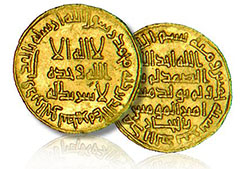 After the movement of Rome to Constantinople, the Roman Empire became the Byzantine Empire, where it lasted from 498 AD to 1453 AD. There is an extensive body of coinage to draw from in various collections within the Byzantine Empire and because the contemporary value of coins was debased over time, resulting in a more extensive mintage in precious metals, owning a piece of Byzantine gold is considerably more affordable than an earlier one from Rome.
After the movement of Rome to Constantinople, the Roman Empire became the Byzantine Empire, where it lasted from 498 AD to 1453 AD. There is an extensive body of coinage to draw from in various collections within the Byzantine Empire and because the contemporary value of coins was debased over time, resulting in a more extensive mintage in precious metals, owning a piece of Byzantine gold is considerably more affordable than an earlier one from Rome.
Other Cultures
There are many other non-Classical cultures which produced exciting coinage. These include the Chinese, Islamic, Parthian, and Barbarians, among others. These are generally not as well documented or explored and could provide opportunities for enterprising numismatists interested in less familiar areas of antiquity.
The Collections
Armed with some general historic knowledge about varying cultures, we will now elaborate on each, looking to build out various options for your collecting consideration.
Type Sets
One of the classic problems when collecting coins is being able to build variety and complete a set without becoming inundated with coins you may not enjoy as much. In starting your ancient coin collection, a type set may be the ideal way to learn about what coinage you like best and to give you the flexibility to either pick a diverse range of themes or narrow down your focus to a specific emperor or dynasty. Because of the range of metal types and various times of currency debasement, the size and quality of some coins will vary depending on when they were minted. A “complete” typeset would involve a very large number of denominations, many of which are quite rare and expensive. The flexibility of being able to customize your typeset means you can choose only the major denominations which would have been used frequently, and choose designs which are meaningful to you.
Greek Typesets
Greek coins come in numerous varieties based on denomination, which changed depending upon the mint and era during which the coin was minted. Greek coinage originated based on a fixed ratio of weight. One of the first examples of this is the shekel, which weighed as much as 180 grains of barley, and because of its consistency, transactions were able to be measured completely by weight. However, because of the ever-changing values of metals, the final weight fluctuated until a universal standard was created.
One of the most popular coins from Greece was the tetradrachm, minted in silver, weighing between 16 and 17 grams, and between 28 and 31 millimeters in diameter (about the size of a US half dollar but heavier). Tetradrachms come in a very wide range of types and many are very appealing due to their size and intricate designs. Measuring other coins relative to the tetradrachm, the largest Greek coin, the pentekaidekadrachm, weighed more than four tetradrachms, and one would need 192 of the smallest, the hemitartemorion, to make one tetradrachm. Greek sizes are based largely on powers of two, and most fractional sizes are represented, although some are quite rare.
Differing from the drachm, the stater entered as another unit of measure. The largest Greek gold coin is the distater, weighing twice as much as a stater, which became one of the most common denominations of ancient gold coin. Similarly to silver coinage based on the drachm, fractional staters are available as well, down from a hemistater (one-half stater) to a twelfth-stater.
Bronze coins are also available, ranging from the tetrachalkon to the hemichalkon, with the former being eight times heavier than the latter.
In Sicily, the weight scale was based on “litra”, which started with a base weight of 0.057 grams and ranged up to 100 times as heavy in gold and electrum coinage. Similarly to stater and drachm based coins, fractional and multiple weights are available, down to 1/12th-litra in bronze.
Because of the wide variety of designs and types available, it’s possible to create an extremely diverse collection of Greek coinage by collecting based on finding appealing types based in different denominations. We suggest using some of themes presented later in this article to guide your overall direction but then narrow it down based on what type of coin you prefer.
Roman Typesets
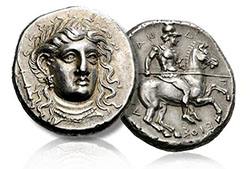 Like the Greeks, Romans minted coins in gold, silver, electrum, bronze, and other less popular metals. Due to the need to raise funds, the weight of each type changed over time, usually becoming considerably lighter later into the empire. There are also some extremely rare denominations which were minted in small quantities, so a complete type set of every denomination ever issued would be difficult to achieve. However, the major types are represented well and can be found at most auctions.
Like the Greeks, Romans minted coins in gold, silver, electrum, bronze, and other less popular metals. Due to the need to raise funds, the weight of each type changed over time, usually becoming considerably lighter later into the empire. There are also some extremely rare denominations which were minted in small quantities, so a complete type set of every denomination ever issued would be difficult to achieve. However, the major types are represented well and can be found at most auctions.
As: The “as” is a Roman bronze coin, produced in fractions as well as multiples, from 1/24th up to five times its base size. After Augustus’ reformation of all of Rome’s coinage, the as was struck in copper instead of bronze.
Dupondius: The dupondius was created and struck in orichalcum, an alloy of bronze which was worth two asses.
Sestertius: The sestertius was originally minted as a denomination worth 2.5 asses but after the reform of Augustus, was set to four asses, or two dupondi. These coins are impressively large, often weighing around 26 grams and having a diameter of 33 millimeters.
Denarius: The denarius, minted in silver, weighed about four grams for the first several centuries of Rome but like the other types, it was debased over time. As an anti-counterfeiting measure, a serrated version of the denarius was also released where small cuts were minted into the edges of the coins, a predecessor to the reeding we see in today’s coinage. The denarius is generally considered to have been a day’s wage for an average worker.
Antoninianus: Originally issued by Caracalla and valued at two denarii, the antoninianus has a storied past which resulted in a considerable amount of inflation. At its introduction, the silver content was only worth 1.5 denarii, resulting in people hoarding denarii. Because of a shortage of silver, the intrinsic metal value of the antoninianus was debased over time by replacing more and more silver with bronze. These coins are very available today and a typeset can be constructed solely from them, showing their progression over the space of just a few decades and how it represents the inflation which Rome experienced.
Aureus: Often held as the centerpiece to a Roman coin collection, the aureus is a Roman gold coin, worth 25 denarii, minted throughout most of Rome’s history. It started between 7.6 to 8.0 grams but was debased several times throughout its history. Most aurei will be at least 7.1 grams, until 294 AD when Diocletian reduced it to about five grams. These coins are always in demand and highly desirable. Low grade examples are relatively inexpensive but higher grade examples and problem-free coins quickly have a much higher premium associated with them. The aureus was eventually transitioned into the solidus by Constantine I where it lost half of its weight, becoming wider and thinner.
Roman Emperors
The Twelve Caesars mark only the beginning of the long and storied Roman Empire. We treat the first twelve differently due to the research commissioned by Hadrian, the 15th Caesar, to create an account of the earlier emperors from primary sources. This has caused the first Twelve Caesars to be grouped together, but they can be separated into sub-groups which can make for a more manageable collection.
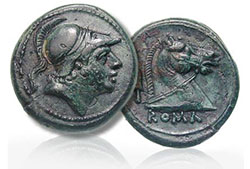 Julio-Claudian Dynasty: Marking the beginning of the Roman Empire, this dynasty was composed of the first six rulers: Julius, Augustus, Tiberius, Caligula, Claudius, and Nero. Julius had very few portrait coins issued and they are all very rare, but there are alternate issues which can be used to complete this collection.
Julio-Claudian Dynasty: Marking the beginning of the Roman Empire, this dynasty was composed of the first six rulers: Julius, Augustus, Tiberius, Caligula, Claudius, and Nero. Julius had very few portrait coins issued and they are all very rare, but there are alternate issues which can be used to complete this collection.
Augustus, formerly Octavian during the Imperatorial period of Rome, is credited with truly beginning the Roman Empire. Tiberius, the emperor of Rome during the lifetime of Jesus, was deeply conservative and refused to be called a god. He minted a large number of gold and silver coins, the latter of which is referenced in the Bible as a “tribute penny”. Caligula, also known as Gaius, became consumed by his power and was assassinated in AD 41. Of the first six, Caligula is the most expensive and rare, ruling for only four years, but still managing to create a name of infamy for himself. Claudius, the 50-year-old uncle of Caligula, was made emperor by the Praetorian Guard, and he proceeded to conquer most of Britain and rule for thirteen successful years until he was poisoned by his fourth wife. His successor, Nero, one of the most recognizable Emperors, employed philosophers and other counselors to aid in his rule, which began at the age of 17. He was multi-talented, entering in musical and poetry contests throughout the Empire. Against common knowledge, it is now believed that Nero did not actually “fiddle as Rome burned”, but in fact, he personally led the efforts to rebuild it, using a considerable amount of his own wealth to fund the effort.
Year of the Four Emperors: Rome had many tumultuous periods but following Nero’s death in 68AD, Galba, Otho, and Vitellius managed to rule only for a few months, each dying during Rome’s civil war, to be succeeded by Vespasian who managed to rule for ten years. The coinage of these emperors is very rare and due to their short tenure, each of them had relatively little impact on history compared to their contemporaries. Otho is generally the most expensive emperor of the first twelve and can make completing a set in any metal difficult for many collectors, which is why it may make sense to focus on other dynasties that ruled for a more significant amount of time, making more of a mark on history and subsequently issuing more diverse coinage.
Flavian Dynasty: After Vespasian was declared Emperor by his armies in Egypt, some degree of normalcy returned to Rome. Vespasian is remembered as a wise Emperor and worked hard to repair the relationship with the Senate. He was followed by his son Titus, who won the Roman war in Judea and erected the Arch of Titus which still stands today. Domitian was the younger son of Vespasian and successor to Titus, but did not continue the path of reducing tensions between the areas of government and instead oppressed religious groups and forced everyone to refer to him as a god.
Nerva-Trajan Dynasty: Following the Twelve Caesars, the next emperors were known as the “Adoptive Emperors”, as instead of using their bloodline to dictate succession, they adopted the best candidate and trained them for the job of Emperor. Nerva, Trajan, and Hadrian were the start of this movement, each making a positive contribution to Rome and growing its borders considerably. Nerva ruled for only two years but Trajan and Hadrian served for nineteen and twenty-one years, respectively.
Antonines: Aelius, one of Hadrian’s adopted sons, was originally expected to take the throne but he died tragically before he could do so, making his coinage quite scarce. Continuing with the new tradition of adopted emperors, Antoninus Pius, Aelius’ brother, was appointed by Hadrian with the condition that he would then appoint Marcus Aurelius and Lucius Verus to the throne after himself. During the twenty-three year long reign of Antoninus Pius, Rome avoided its prior history of constant battle, and existed in a period of relative peace. Antoninus Pius pioneered several key ideas that have shaped our world today, including the concepts of being innocent until proven guilty, equality of women, and rights for orphans. Alongside his co-emperor Lucius Verus, Marcus Aurelius, “the Philosopher Emperor”, ruled for nineteen years and continued Antoninus Pius’ work on morality and equality. However, instead of adopting his successor, he chose his son, Commodus, to whom many attribute the initial decline of the Roman Empire, after seeming promising during the initial years of his reign.
There are several additional periods after the Antonines, filled with a rollercoaster of backward and forward progress within the Roman Empire. Each of these can be collected separately or specific emperors can be chosen from them to build a broad, historic collection. These later emperors are generally broken into The Severan Period, The Crisis, Decline, and Recovery of the Empire, the Secessionist Emperors, the Tetrarchy, the Constantines, and the Late Empire.
Themed Sets
Classical numismatics provides a large number of themes which can be incorporated as typesets or as standalone sets. Because of similar historic mythology, there is some overlap between Greek and Roman coinage which can make for a very appealing, wide-reaching set. Here are a few suggestions:
Animals: Antelope to Wolf and almost any in-between. Particularly popular are birds, bulls, dolphins, horses, lions, and the mythical Pegasus. These coins have wide appeal and are immediately recognizable. Most animals are present in all denominations and metals and particularly in Greek coinage, the animals are present on both the obverse and reverse, so one can create a very diverse set.
Large coins: Between the Romans and the Greeks, large coins usually had extremely intricate designs, created with great artistic prowess. There are few feelings more exciting than holding a large Roman sesteterius in your palm, a coin which is often larger than a US half dollar and considerably heavier. Large bronze coins likes the sestertius are available in all price ranges depending on the level of detail. Large Greek coins like the tetradrachm, minted in silver, can be expensive depending on the artistic quality and preservation, but there are many examples which were minted in large quantities and can therefore be purchased by a wider range of collectors. The Greek dekadrachm (in silver) and the octadrachm (in gold) are some of the most expensive coins of antiquity but also offer some of the most visually stunning designs. The dekadrachm has often been referred to as the pinnacle of quality of Greek coinage and is the centerpiece of most major collections.
Military: Neither Greece nor Rome was a peaceful civilization. Therefore, the military was consistently a large facet of everyday life. Their coinage frequently celebrated warfare and the implements used in battle. Arms, armor, depictions of combat, and representations of victory appear with considerable frequency and can provide a visually diverse but consistent theme to a collection.
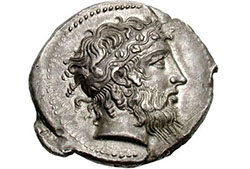 Muses: In 56BC, the Roman Republic minted a set of nine denarii, each of a different famous muse, from the statues brought to Rome by Fulvius Nobilior from his victories in Aetolia. These statues were placed in the temple of Hercules Musarum, which was built by the mythical ancestor of Q. Ponponius Musa. The muses depicted cover most classical studies: epic, adult, and lyric poetry, rhetoric, tragedy, comedy, dancing, history, and astronomy. With interesting reverse types, these comprise a lesser-known set which is filled with history and modern connections, showing that human creativity and artistic appreciation have remained surprisingly consistent for the last two thousand years.
Muses: In 56BC, the Roman Republic minted a set of nine denarii, each of a different famous muse, from the statues brought to Rome by Fulvius Nobilior from his victories in Aetolia. These statues were placed in the temple of Hercules Musarum, which was built by the mythical ancestor of Q. Ponponius Musa. The muses depicted cover most classical studies: epic, adult, and lyric poetry, rhetoric, tragedy, comedy, dancing, history, and astronomy. With interesting reverse types, these comprise a lesser-known set which is filled with history and modern connections, showing that human creativity and artistic appreciation have remained surprisingly consistent for the last two thousand years.
Monuments: Some of the most historically relevant and interesting coinage of both Greece and Rome depict famous buildings and structures. Many of these monuments are no longer standing today but we can connect back to them through their coinage. Arguably the most famous and sought-after example of this type is of the Flavian Amphitheater, or Colosseum. With it engraved in its former, undamaged glory, we can see what it looked like intact before it was forced to withstand several earthquakes and disasters. More within the reach of the average collector, the Roman emperor Trajan was well-known for his architecture and several of his coins depict his Forum in extraordinary detail. While his Forum is no longer standing today, another of his coins, with a reverse of his Column, shows this architectural masterpiece accurately to how it looks today, which was built to mark the height of the land he and his armies levelled to create his courtyards.
Gods and Olympians: The mythology of Greece and Rome is filled with numerous tales of the great acts of their Gods, and their coinage frequently reflects these. A set of various coins of popular mythological figures can be a great way to convey history’s stories and provide a bridge of fascination to collectors and non-collectors alike. Nearly every god and goddess from Aphrodite to Zeus is paid homage through coins minted by their followers.
Family: Emperors often minted coins of their children and families. Antoninus Pius celebrated his family and had several coins with many of his children shown together on the reverse. During the dynasty of the Adoptive Emperors, coins were minted celebrating the new members of the family, which weren’t related by blood. When lineage was predetermined, coins were often issued before an emperor ascended to the throne, depicting a young emperor-to-be under his father’s name.
History: Alexander the Great conquered a vast amount of the world in the name of Greece. After claiming most of the world’s gold for his own, he began melting and producing a large number of gold coins with Athena on the obverse and Nike on the reverse. These coins, minted around 336BC and most often seen in the denomination of a Greek stater, are visually stunning and truly historic.
Historic women: Roman Emperors often minted coins depicting their wives and these can form a very desirable collection alongside that of the more conventional male portraits. In Ancient Greece, Ptolemaic coinage often depicts the wives of the rulers. Berenike and Arsinoe are pictured on octadrachms and dekadrachms, as well as the rare and heavy dodekadrachm, a coin weighing around 54 grams.
Olympics: With the Olympics being such a significant part of Greek life, it is understandable how often they picture specific Olympic events and games on coinage. Similar games are portrayed on Roman coins as well, transitioning into chariots drawn by horses and battle scenes. Greek tetradrachms, with their large diameters, gave engravers enough space to depict detailed scenes of specific games and celebrate the strength of their people.
Geography: Hadrian famously traveled throughout the empire, unlike many emperors who stayed close to Rome. He minted a series of coins chronicling his travels, ranging from Africa, to Egypt, Spain, and across the Nile. These coins reveal an interesting attribute of our world, in that despite being nearly two thousand years detached, the same places with the same names are still frequently visited by travelers.
Provenance: Many famous collections have been formed over the last several centuries, and coins can often be tracked to these collections, establishing a provenance of previous owners. This adds to the appeal of these coins by highlighting the fact that they were chosen by their previous owners as their examples of a type alongside other world-class coins. As an added benefit, legal ownership of coins is easier to establish, reducing risk of coins having been stolen or acquired from illegal archaeological dig sites. Various hordes have also been uncovered and subsequently sold to the market and coins can often realize a premium because of the added history associated with these finds. One particularly exciting example is the Boscoreale horde, unearthed in 1895 as a part of the excavation of Pompeii. The coins discovered here have very interesting toning patterns due to the fact that they had been buried under the ash and debris from the eruption of Vesuvius over 1800 years prior.
Next Steps
Now with some background on the history of coinage and a variety of options, you should be able to begin or continue your journey into ancient coin collecting. There is a lot to choose from and more written about ancient coins than could ever be read in a lifetime, but armed with a broader view on what is available, we hope that you will be able to make more informed selections and continue finding pieces which excite you for years to come.
Happy hunting!



